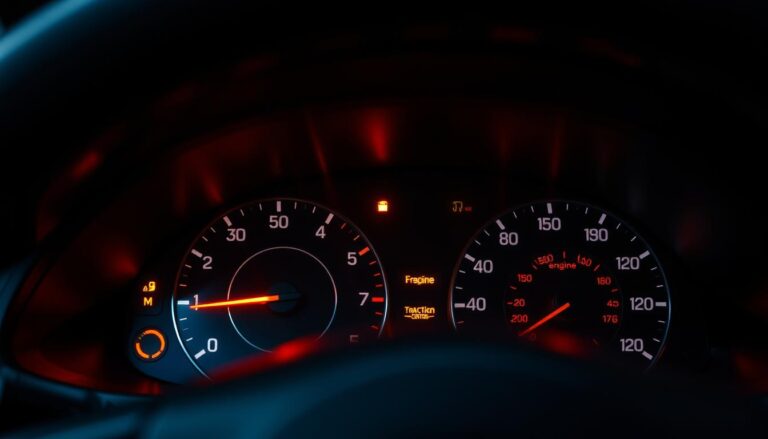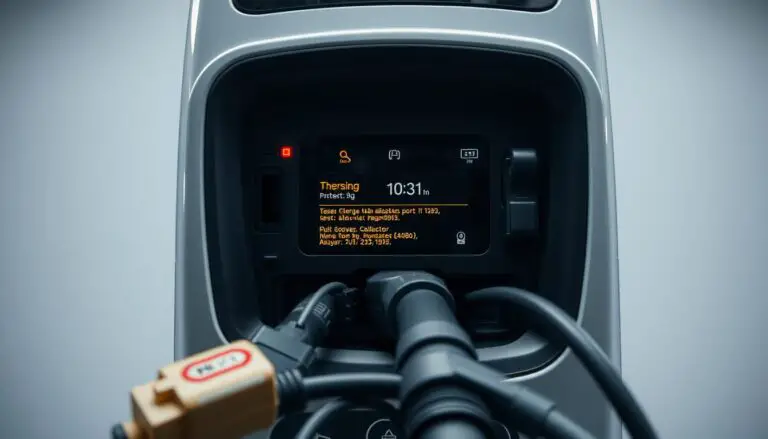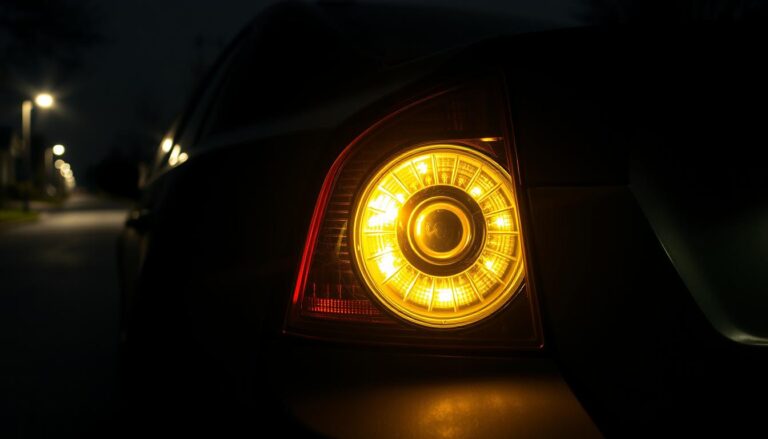When you think of Volvo, safety immediately comes to mind. For decades, the Swedish manufacturer has built its reputation on creating some of the safest vehicles on the road. But does this commitment to safety extend to protecting your car from theft? In an age where car theft techniques are becoming increasingly sophisticated, many prospective and current Volvo owners wonder: Are Volvos truly harder to steal than other vehicles?
This comprehensive analysis explores Volvo vehicle security systems, examines real-world theft statistics, and provides actionable recommendations to keep your Volvo secure.
Key Takeaways: Volvo Vehicle Security
- Volvos feature advanced anti-theft technology including encrypted key fobs, immobilizers, and the Volvo On Call system with theft tracking capabilities
- Statistical data shows Volvos have lower theft rates compared to many luxury competitors, but they’re not immune to sophisticated theft techniques
- Modern Volvos are vulnerable to relay attacks targeting keyless entry systems, though Volvo has implemented countermeasures in newer models
- Supplementary security measures like steering wheel locks, GPS trackers, and secure key storage significantly enhance your Volvo’s theft protection
- Volvo’s continuous security updates and owner vigilance are essential for maintaining strong vehicle protection against evolving theft methods
Volvo’s Approach to Vehicle Security
Volvo’s integrated security system combines physical and digital protection measures
Volvo’s approach to vehicle security is an extension of their holistic safety philosophy. While many manufacturers treat anti-theft features as add-ons, Volvo integrates security into the core design of their vehicles. This comprehensive strategy combines traditional mechanical deterrents with cutting-edge digital protection systems.
The Swedish automaker’s security framework has evolved significantly over the decades, from basic mechanical locks to sophisticated electronic systems that communicate with satellites and mobile networks. Today’s Volvo security systems represent the culmination of this evolution, offering multi-layered protection against various theft techniques.
Core Anti-Theft Technologies in Modern Volvos
Electronic Immobilizer Systems
At the heart of Volvo’s security architecture is an advanced electronic immobilizer. Unlike basic immobilizers that simply prevent hot-wiring, Volvo’s system uses encrypted communication between the key and vehicle. This technology makes it virtually impossible to start the engine without the authentic key, even if a thief gains physical access to the vehicle’s interior.
Advanced Key Encryption
Volvo key fobs utilize sophisticated rolling-code encryption that changes the transmission code each time the key is used. This prevents thieves from capturing and replaying the signal—a common technique used to bypass simpler keyless entry systems. The encryption algorithms are regularly updated to stay ahead of emerging hacking methods.
Perimeter and Interior Protection
Modern Volvos employ a network of sensors that monitor both the vehicle’s perimeter and interior. These include tilt sensors that detect unauthorized towing, glass break sensors, and motion detectors that can distinguish between normal environmental movements and actual intrusion attempts. When triggered, these sensors activate both audible alarms and silent alerts to the owner.
Volvo On Call: Connected Security
The Volvo On Call system represents one of the most advanced vehicle security platforms available. This integrated service provides real-time tracking, remote immobilization, and automatic theft notification. If your Volvo is stolen, the system can pinpoint its location and assist law enforcement in recovery efforts, significantly increasing the chances of retrieving your vehicle intact.
Volvo Theft Statistics: How Do They Compare?
To objectively assess Volvo’s security effectiveness, we need to examine actual theft statistics. The data reveals interesting patterns about how Volvos fare compared to other luxury vehicles when it comes to theft vulnerability.
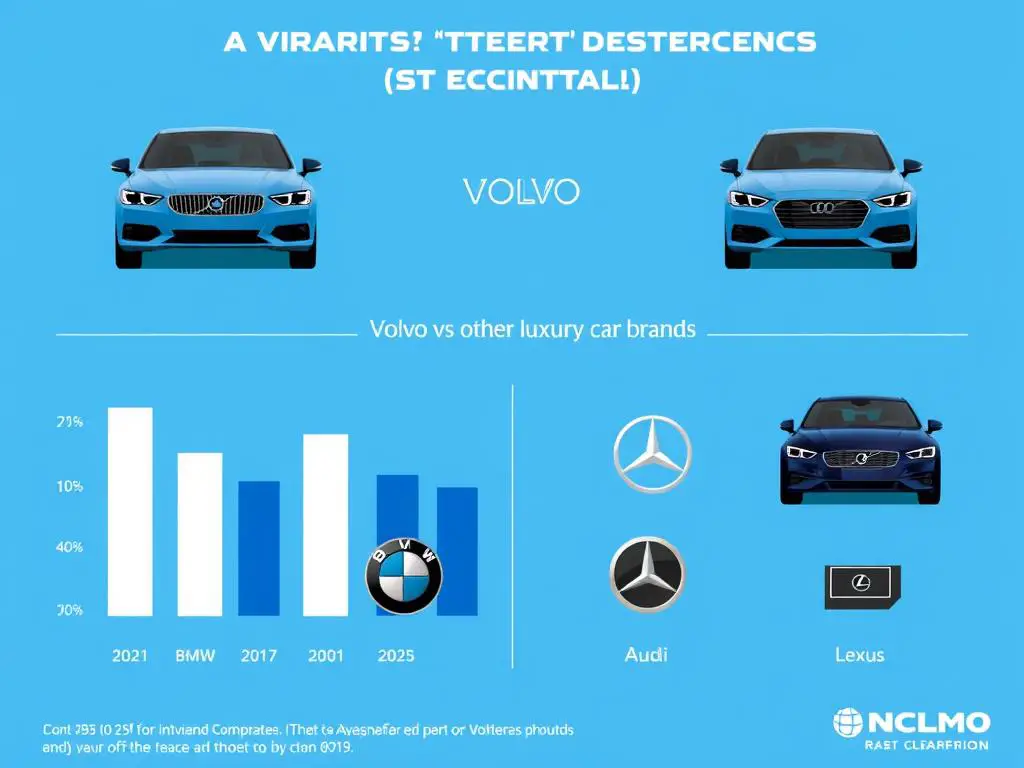
Comparative theft rates per 1,000 registered vehicles across luxury brands
According to the Highway Loss Data Institute (HLDI), Volvo models consistently rank among the least stolen luxury vehicles. The most recent comprehensive data shows that Volvos have a theft claim frequency approximately 30% lower than the average for luxury vehicles in the same class. This statistic is particularly impressive considering the premium materials and technology that make luxury vehicles attractive targets for thieves.
| Vehicle Model | Theft Rate (per 1,000 vehicles) | Recovery Rate (%) | Most Targeted Model Year |
| Volvo XC90 | 0.4 | 86% | 2018 |
| Volvo S60 | 0.7 | 82% | 2019 |
| Volvo XC60 | 0.6 | 84% | 2020 |
| BMW X5 | 1.7 | 61% | 2021 |
| Mercedes-Benz GLE | 1.4 | 65% | 2020 |
Insurance industry data further supports Volvo’s strong security performance. Many insurance providers offer discounted premiums for Volvo owners, acknowledging the reduced theft risk associated with the brand. This translates to tangible financial benefits for Volvo owners beyond the peace of mind that comes with enhanced security.
“Volvo has consistently demonstrated a commitment to vehicle security that goes beyond industry standards. Their multi-layered approach to theft prevention, combining physical deterrents with advanced electronic systems, has resulted in notably lower theft rates compared to competitors in the luxury segment.”
However, it’s important to note that no vehicle is completely theft-proof. While Volvos show impressive resistance to conventional theft methods, they face the same vulnerabilities as other modern vehicles when it comes to sophisticated electronic attacks. The next section examines these vulnerabilities and how Volvo addresses them.
Security Vulnerabilities: Where Volvos May Be At Risk
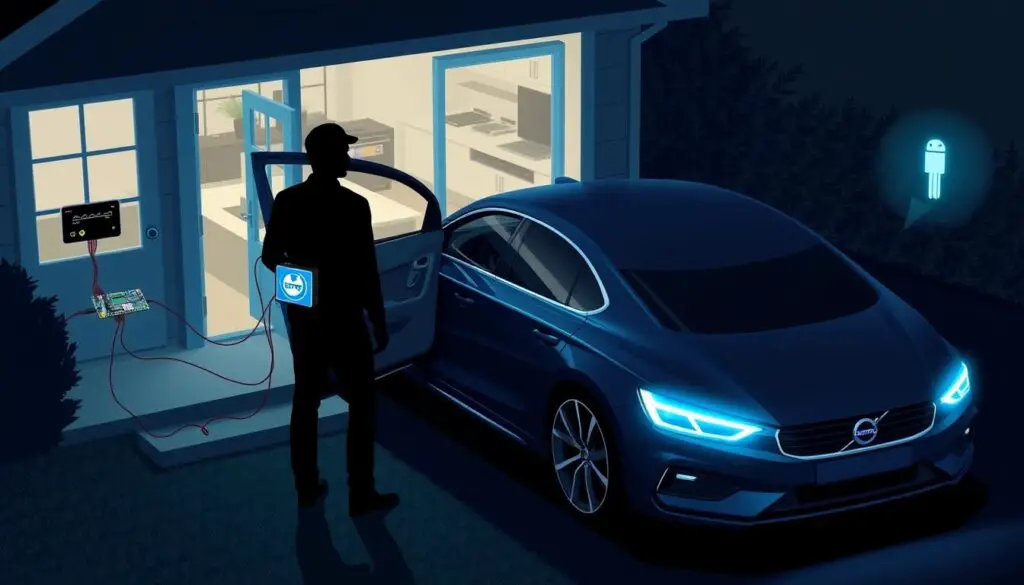
Relay attacks exploit vulnerabilities in keyless entry systems by amplifying key signals
Despite Volvo’s robust security measures, modern vehicles face evolving threats from increasingly sophisticated thieves. Understanding these vulnerabilities is essential for comprehensive protection of your Volvo.
Relay Attacks on Keyless Entry Systems
The most significant vulnerability in modern Volvos—and indeed most premium vehicles with keyless entry—is susceptibility to relay attacks. These attacks exploit the convenience of keyless entry systems by intercepting and amplifying the signal between your key fob and vehicle, even when the key is inside your home.
In a typical relay attack, thieves use specialized electronic devices that can detect and extend your key’s signal from up to 100 meters away. One thief positions a device near your home where the key is located, while another stands by the vehicle with a second device that receives and retransmits the signal. This tricks your Volvo into thinking the authentic key is present, allowing thieves to unlock and start the vehicle.
On-Board Diagnostic (OBD) Port Exploitation
Another potential vulnerability is the On-Board Diagnostic (OBD) port, which provides access to your vehicle’s computer systems. Sophisticated thieves can use specialized devices connected to this port to program new keys or bypass security systems. While Volvo has implemented safeguards to protect the OBD port, determined thieves with the right equipment may still exploit this access point.
How Volvo Addresses These Vulnerabilities
Signal-Blocking Technology
To counter relay attacks, newer Volvo models incorporate signal-blocking technology that prevents key signals from being transmitted when the key is stationary for a set period. This means that even if thieves attempt to amplify your key’s signal while it’s sitting on your kitchen counter, the key won’t respond to their devices.
Motion-Sensitive Keys
Volvo has also introduced motion-sensitive key fobs that deactivate when not in use. These keys contain accelerometers that detect movement, only activating the transmission capability when the key is being carried. When stationary, the key enters a sleep mode that prevents signal interception.
Enhanced OBD Port Security
To protect against OBD port exploitation, Volvo has implemented additional authentication requirements for accessing critical vehicle systems. This includes encrypted communication protocols and multi-factor authentication for programming new keys or modifying security settings.
Continuous Security Updates
Perhaps most importantly, Volvo provides regular security updates for their vehicles, similar to how smartphone manufacturers patch security vulnerabilities. These updates can be installed during routine service visits or, in newer models, delivered wirelessly through the Volvo On Call system.
Important Security Alert
Even with Volvo’s advanced security features, no vehicle is completely immune to determined thieves with sophisticated equipment. Supplementary security measures are strongly recommended, especially if you live in a high-theft area or own a particularly desirable Volvo model.
Real-World Case Studies: Volvo Theft Attempts
Examining actual theft attempts provides valuable insights into how Volvo’s security systems perform in real-world scenarios. These case studies highlight both the strengths and potential weaknesses of Volvo vehicle security.
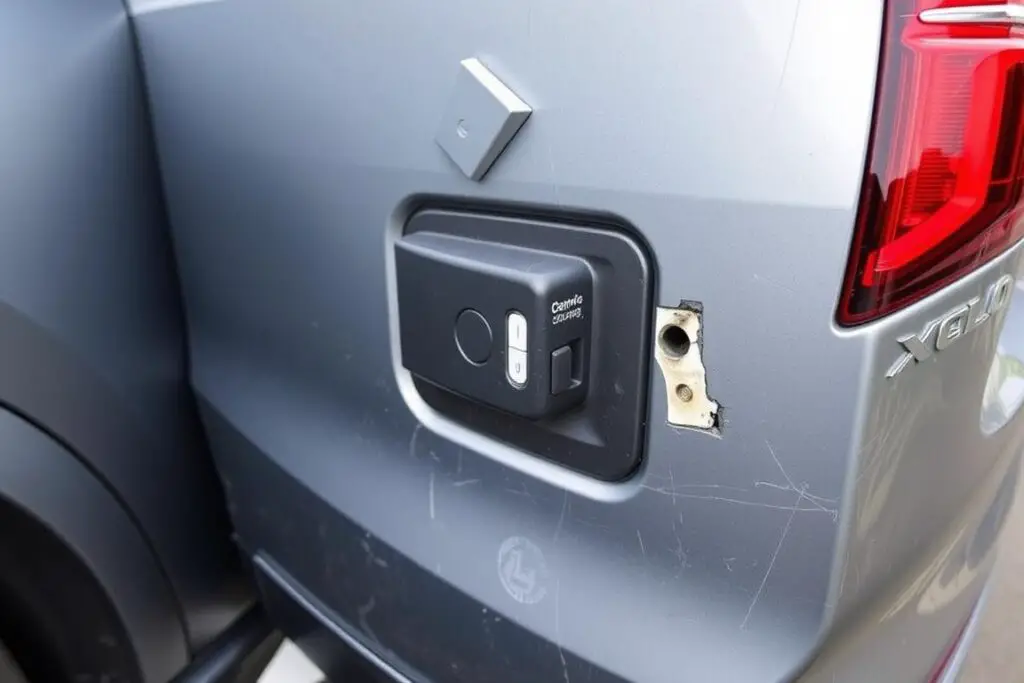
A recovered Volvo XC90 after an unsuccessful theft attempt in London
Case Study 1: Thwarted Relay Attack on Volvo XC60
In 2022, security cameras in a suburban neighborhood captured footage of thieves attempting a relay attack on a 2021 Volvo XC60. The thieves positioned one device near the homeowner’s front door while another approached the vehicle. Despite multiple attempts, they were unable to start the vehicle due to Volvo’s motion-sensitive key technology, which had deactivated the key’s signal while it was stationary inside the home.
This case demonstrates the effectiveness of Volvo’s newer anti-relay attack measures. The owner had not taken any additional precautions beyond the vehicle’s built-in security, yet the system successfully prevented theft.
Case Study 2: Successful Theft of Older Volvo S90
Conversely, a 2017 Volvo S90 was successfully stolen from a shopping center parking lot using a combination of techniques. Thieves first gained entry using a relay device to capture the key signal from the owner’s pocket as they shopped nearby. Once inside, they used an OBD device to bypass the immobilizer and program a new key.
This case highlights the vulnerability of older Volvo models that lack the latest security updates and anti-relay technology. It also emphasizes the importance of supplementary security measures, particularly for Volvos manufactured before the implementation of enhanced anti-relay protections.
Case Study 3: Recovery of Stolen Volvo XC90 via Volvo On Call
A 2020 Volvo XC90 was stolen from a residential driveway using sophisticated electronic equipment. However, the vehicle was equipped with Volvo On Call, which allowed the owner to track the vehicle’s location in real-time. Law enforcement was able to recover the vehicle within hours, before any significant damage or parts removal could occur.
This case demonstrates the value of Volvo’s connected security features in the recovery process. Even when primary security measures are compromised, secondary systems like Volvo On Call significantly increase the chances of vehicle recovery.
Comparative Security: Volvo vs. Competitors
| Security Feature | Volvo | BMW | Mercedes-Benz | Tesla |
| Advanced Immobilizer | Standard | Standard | Standard | Standard |
| Anti-Relay Protection | Standard (2019+) | Optional | Standard (2021+) | Standard |
| GPS Tracking | Standard with On Call | Subscription | Subscription | Standard |
| Remote Immobilization | Yes (On Call) | Limited | Yes | Yes |
| OTA Security Updates | Yes (newer models) | Limited | Yes | Comprehensive |
These case studies and comparisons reveal that while Volvo’s security systems are generally robust, their effectiveness varies by model year and the specific technologies implemented. Newer Volvos with the latest security features demonstrate impressive resistance to common theft techniques, while older models may benefit from additional security measures.
Enhancing Your Volvo’s Security: Owner Recommendations
While Volvo’s built-in security systems provide strong protection, implementing additional measures can significantly reduce theft risk. These practical recommendations complement your vehicle’s existing security features.
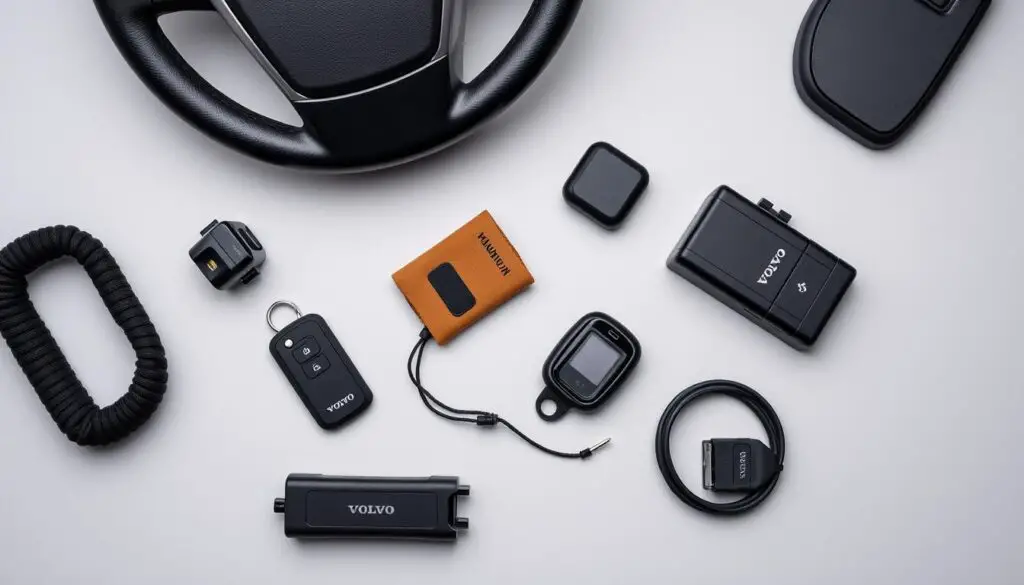
Supplementary security devices provide additional layers of protection for your Volvo
Physical Deterrents
Steering Wheel Locks
Despite their simplicity, visible steering wheel locks remain effective deterrents. Thieves typically seek the path of least resistance, and the presence of a sturdy steering wheel lock often encourages them to move on to easier targets. Look for models with hardened steel construction and pick-resistant locks for maximum effectiveness.
OBD Port Locks
These devices physically secure your vehicle’s diagnostic port, preventing thieves from accessing it to program new keys or bypass security systems. Quality OBD port locks are inexpensive yet provide significant protection against a common vulnerability.
Wheel Clamps
For long-term parking or vehicles stored for extended periods, wheel clamps provide highly visible and effective theft prevention. Modern designs are resistant to cutting and tampering while remaining relatively easy for the owner to install and remove.
VIN Etching
Having your Vehicle Identification Number (VIN) etched onto windows and major components makes your Volvo less attractive to professional thieves who strip vehicles for parts. This permanent marking makes parts traceable and significantly reduces their resale value on the black market.
Electronic Security Enhancements
Signal-Blocking Pouches
Also known as Faraday pouches, these simple devices block your key fob’s signal when not in use, preventing relay attacks. When your key is inside the pouch, its signal cannot be intercepted or amplified, effectively neutralizing the most common electronic theft method used against modern vehicles.
Aftermarket Alarm Systems
While Volvos come with factory alarm systems, aftermarket alarms can provide additional features such as glass break detection, proximity sensors, or backup power sources that continue to function even if thieves attempt to disconnect the vehicle’s battery.
GPS Trackers
Independent GPS tracking devices provide an additional layer of location monitoring beyond Volvo On Call. The best systems offer real-time tracking, geofencing capabilities (alerts when your vehicle leaves a designated area), and battery backup to function even if thieves disable the vehicle’s electrical system.
Dashcams with Parking Mode
Modern dashcams with parking surveillance mode can record attempted break-ins and automatically upload footage to cloud storage. Some models even send real-time alerts to your smartphone when they detect suspicious activity around your parked Volvo.
Practical Security Habits
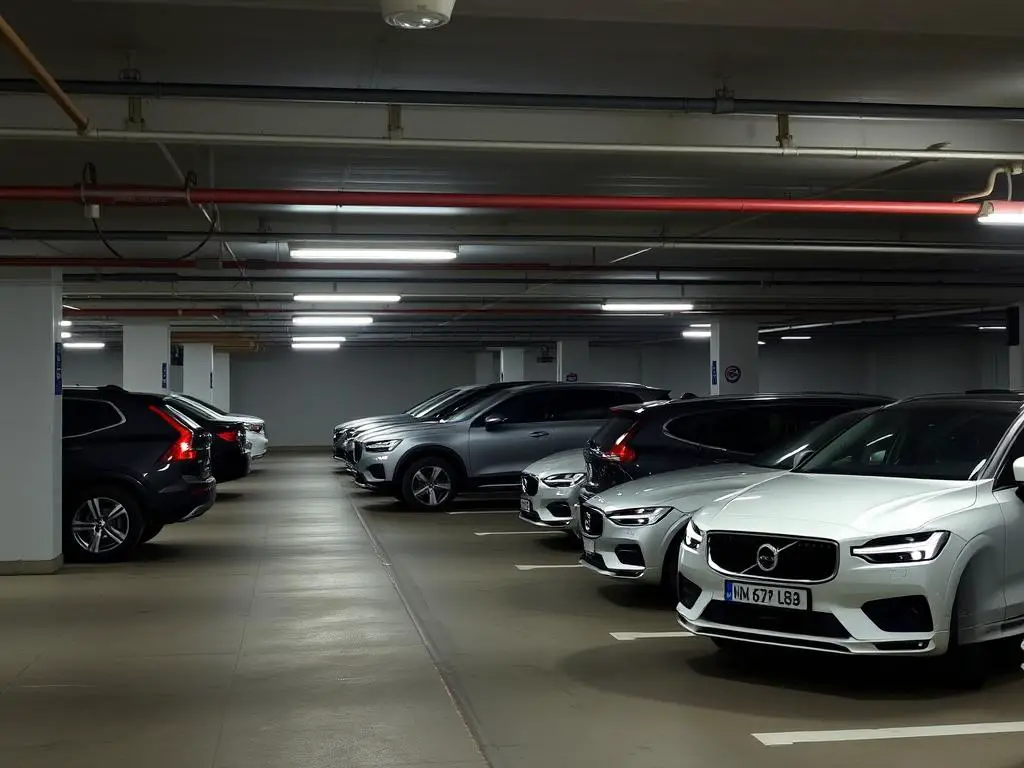
Secure parking environments significantly reduce theft risk
- Always park in well-lit, high-traffic areas whenever possible
- Store your key fob at least 10 feet from exterior walls when at home
- Consider turning off the keyless entry feature in your vehicle’s settings when not needed
- Keep your Volvo’s software updated to benefit from the latest security patches
- Remove valuables from sight, even in a secure vehicle like a Volvo
- Use secure parking facilities with controlled access when available
- Consider home security measures that protect your keys as well as your home
Insurance Considerations for Volvo Owners
Many insurance providers offer discounts for vehicles with advanced security features and for owners who implement additional security measures. When insuring your Volvo, be sure to:
- Inform your insurer about all security features present in your Volvo
- Ask about discounts for aftermarket security devices you’ve installed
- Consider comprehensive coverage that includes theft protection
- Check if your policy covers personal items stolen from your vehicle
- Inquire about reduced premiums for parking in secure locations
Implementing even a few of these recommendations can significantly enhance your Volvo’s security profile. The layered approach—combining your vehicle’s built-in systems with physical deterrents, electronic enhancements, and security-conscious habits—provides the most comprehensive protection against both opportunistic and sophisticated theft attempts.
Volvo On Call: The Ultimate Anti-Theft Tool

The Volvo On Call app provides comprehensive security monitoring and control
Volvo On Call deserves special attention as one of the most comprehensive connected security systems available in any vehicle. This subscription-based service transforms your smartphone into a powerful security command center for your Volvo.
Key Security Features of Volvo On Call
Real-Time Tracking
If your Volvo is stolen, Volvo On Call provides precise GPS location tracking viewable through the smartphone app. This information can be shared directly with law enforcement to facilitate rapid recovery.
Remote Immobilization
In the event of theft, Volvo On Call allows you to remotely immobilize your vehicle, preventing thieves from restarting the engine once it’s been turned off. This feature significantly increases recovery chances.
Automatic Theft Notification
The system automatically alerts you if your alarm is triggered or if the vehicle moves without the key present. These instant notifications allow for immediate response, often before the owner would otherwise realize the theft.
Additional Security Benefits
Remote Lock Control
Forgot to lock your Volvo? The app allows you to remotely lock or unlock your vehicle from anywhere with internet connectivity. This prevents opportunistic theft situations where a vehicle is inadvertently left unsecured.
Security Alerts
Volvo On Call can send notifications for various security-related events, including unauthorized entry attempts, alarm triggers, or if your vehicle is moved without your key. These early warnings are crucial for prompt response to potential theft situations.
Driving Journals
The system maintains detailed logs of all trips, providing evidence of when and where your vehicle has been driven. This information can be invaluable for both theft investigation and recovery efforts.
24/7 Security Center
Beyond the app functionality, Volvo On Call includes access to a 24/7 security center staffed by trained professionals who can assist with theft reporting, coordinate with law enforcement, and provide guidance during security incidents.
“Volvo On Call represents one of the most comprehensive connected security systems in the automotive industry. Its combination of real-time tracking, remote immobilization, and instant alerts provides a security framework that significantly outperforms traditional anti-theft systems.”
For Volvo owners, activating and maintaining a Volvo On Call subscription represents one of the most effective security investments available. The system’s ability to both prevent theft and facilitate recovery makes it an essential component of a comprehensive vehicle security strategy.
Volvo On Call Availability
Volvo On Call is standard on most new Volvo models and available as an upgrade for many older vehicles. The service requires an active subscription after the initial complimentary period (typically 3-4 years for new vehicles). Contact your local Volvo dealer to verify compatibility with your specific model.
The Future of Volvo Vehicle Security
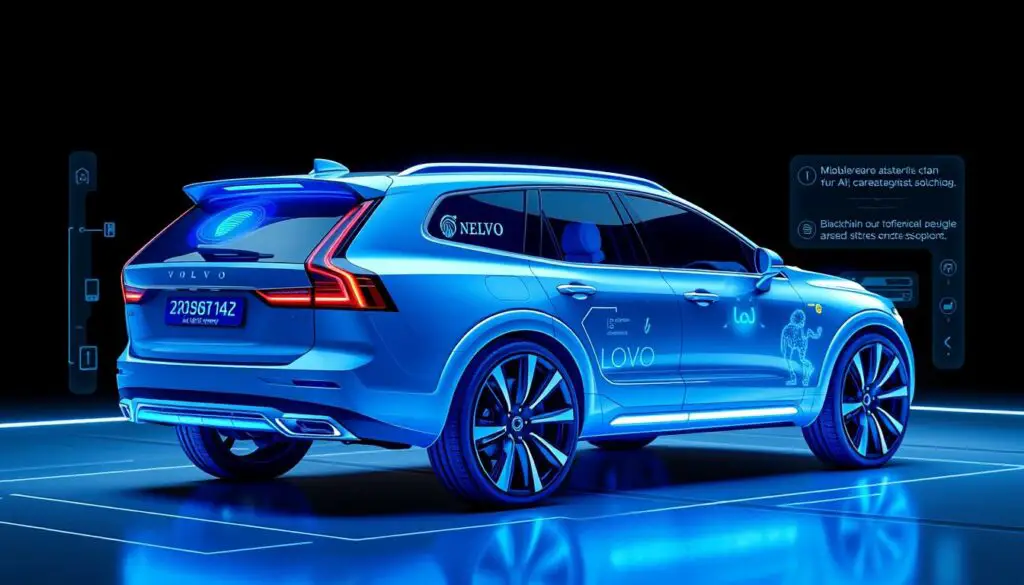
Next-generation Volvo security concepts include biometric authentication and AI monitoring
As vehicle theft techniques continue to evolve, so too does Volvo’s approach to security. The company is investing heavily in next-generation protection systems that promise to further strengthen their vehicles against emerging threats.
Emerging Security Technologies
Biometric Authentication
Volvo is exploring biometric security measures, including fingerprint recognition and facial scanning, to create an additional layer of authentication beyond traditional keys. These systems would ensure that only authorized individuals can access and operate the vehicle, even if electronic key systems are compromised.
AI-Powered Threat Detection
Artificial intelligence systems that can identify suspicious behavior around the vehicle represent another frontier in security. These systems use machine learning to distinguish between normal activity and potential theft attempts, triggering appropriate responses based on the perceived threat level.
Ultra-Wideband (UWB) Technology
To counter relay attacks, Volvo is implementing ultra-wideband technology that provides precise distance measurement between the key and vehicle. Unlike traditional keyless systems that can be fooled by signal amplification, UWB technology can determine the exact location of the key, preventing relay attacks.
Blockchain-Based Security
Blockchain technology offers promising applications for vehicle security, creating tamper-proof digital identities for vehicles and authorized users. This could revolutionize key authentication and prevent the programming of unauthorized keys through the OBD port.
Volvo’s Security Development Roadmap
Volvo has outlined an ambitious security development roadmap that emphasizes proactive protection against emerging threats. Key elements of this strategy include:
- Regular security audits conducted by independent cybersecurity firms to identify potential vulnerabilities
- Collaboration with law enforcement agencies to understand evolving theft techniques
- Over-the-air security updates that can rapidly deploy patches for newly discovered vulnerabilities
- Integration of security features across the entire vehicle ecosystem, including connected services and mobile applications
- Enhanced owner education programs to promote security awareness and best practices
This forward-looking approach reflects Volvo’s understanding that vehicle security is not a static achievement but an ongoing process that requires continuous innovation and adaptation. By anticipating future threats and developing countermeasures before those threats become widespread, Volvo aims to maintain its position as a leader in vehicle security.
Are newer Volvo models more secure than older ones?
Yes, newer Volvo models generally incorporate more advanced security features, particularly against electronic theft methods. Models manufactured after 2019 typically include anti-relay attack technology, enhanced encryption, and more sophisticated immobilizer systems. However, older Volvos still benefit from the brand’s robust mechanical security and can be upgraded with aftermarket security devices.
Does Volvo On Call work internationally?
Volvo On Call functions in most countries where Volvo operates, but coverage may vary by region. The tracking and security features generally work across international borders within covered regions, making it effective even if your vehicle is taken across country lines. However, it’s advisable to check specific country coverage if you frequently travel internationally with your Volvo.
Can I disable keyless entry on my Volvo to prevent relay attacks?
Many newer Volvo models allow you to disable the keyless entry feature through the vehicle’s infotainment system settings. This requires using the physical key or button press on the fob to unlock the vehicle, eliminating the vulnerability to relay attacks. Consult your owner’s manual or Volvo dealer for model-specific instructions on disabling this feature.
Conclusion: Are Volvos Easy to Steal?
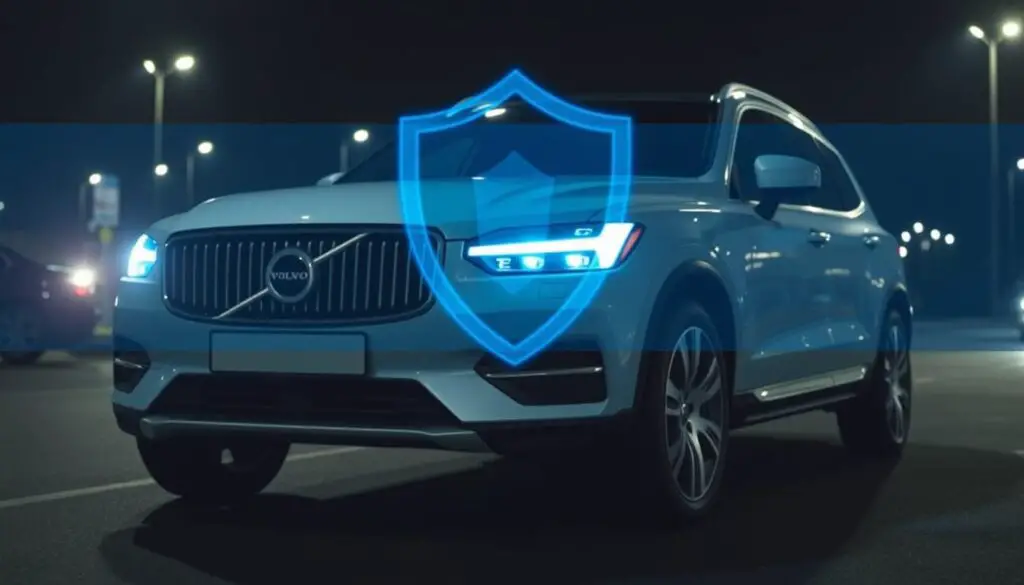
Volvo’s multi-layered security approach provides comprehensive protection
Based on our comprehensive analysis of Volvo vehicle security features, theft statistics, and real-world case studies, we can draw several conclusions about the theft resistance of Volvo vehicles.
Volvo Security Strengths
- Advanced factory security systems that exceed industry standards
- Consistently lower theft rates compared to competitors in the same class
- Excellent recovery rates through Volvo On Call and tracking technology
- Regular security updates that address emerging vulnerabilities
- Strong mechanical security that deters opportunistic thieves
Volvo Security Limitations
- Older models vulnerable to sophisticated electronic attacks
- Keyless entry systems susceptible to relay attacks (pre-2019 models)
- Premium status makes them attractive targets for professional thieves
- OBD port vulnerabilities similar to other luxury vehicles
- Security effectiveness varies significantly by model year and equipment
To directly answer the question posed in our title: No, Volvos are not easy to steal compared to most other vehicles. Their comprehensive security systems, particularly in newer models, provide robust protection against common theft techniques. The statistical data supports this conclusion, with Volvos consistently showing lower theft rates than many competitors in the luxury segment.
However, no vehicle is completely theft-proof, and Volvos face the same evolving threats as other modern vehicles. The most effective approach to Volvo security combines the vehicle’s built-in protections with owner vigilance and supplementary security measures tailored to your specific model and circumstances.
Volvo’s commitment to security innovation suggests that their vehicles will continue to offer strong protection against theft in the future. By staying informed about emerging threats and implementing appropriate countermeasures, Volvo owners can enjoy both the safety and security that have long been hallmarks of the brand.

